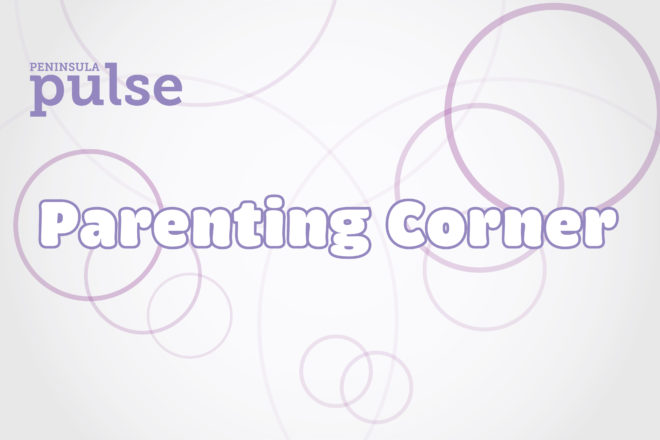Parenting Corner: Calming Public Tantrums
- Share
- Tweet
- Pin
- Share

by KAREN COREKIN-DELAMER, Education and Community Relations Coordinator, Northern Door Children’s Center
Dear Karen,
My 30-month-old daughter has always been very well behaved in public. She goes everywhere with us, and she has never been disruptive – until this changed a few months ago.
We were doing our weekly grocery run at the local big box, and she fell in love with a little stuffed animal. I had to admit it was very cute, so I bought it for her. The next time we went to the store, she immediately asked for another stuffed animal, and this time her dad gave in and bought it. Later, we agreed this wasn’t a habit we wanted to start with her.
On the next trip when she asked for a toy, we both said no. She surprised us by having a huge, screaming tantrum. We quickly gave in and got her the toy. Now the shopping excursions we used to enjoy as a family have turned into stress-filled nightmares.
The minute we say no to a toy, she starts shrieking and crying at the top of her lungs and won’t stop. We’ve even started having one of us stay home with her because her behavior at the store is so awful.
We want to break this cycle of tantrums. Please help!
— Can’t Take the Screaming Anymore
Dear Can’t Take the Screaming,
When your child has a big, public tantrum, it can make you feel very isolated, especially when you sense the judgment of other people. This is very typical behavior in children your daughter’s age, so you are definitely not alone!
One of the keys to changing inappropriate, attention-seeking behavior such as a tantrum is to be aware of how you respond with your attention. Where your attention goes during these moments can make a huge difference in changing your daughter’s behavior because she wants your attention more than a toy or anything else.
Before you take your daughter to the store again, you and her dad should discuss guidelines regarding expectations for your daughter’s behavior and which words you’ll use to communicate them to her. It’s important that you make these decisions together so you’re both consistent.
If you decide that you won’t purchase any toys when grocery shopping, it’s important to tell your daughter. Let her know right before you get in the car to leave that you won’t be buying toys at the store. She may be upset when you tell her, but when she stops crying, calmly acknowledge her feelings by saying, “I know that makes you feel sad because you really want a toy.” Children tend to respond well when they know you understand how they feel.
Before you get out of the car, remind her that she won’t be getting a toy at the store, and that if she screams or cries about a toy while in the store, you will take her out to sit in the car with you until she stops. Say it several times to be sure she understands. This way, she’s clear that if she has a tantrum in the store, she will need to leave until she can stop crying. Decide ahead of time which one of you will be on car duty that day.
And here’s the really important part: If she asks for a toy while you’re in the store, say no. If she screams or cries, the designated parent must immediately take her back to the car. Don’t say anything; just calmly take her out.
If she continues to have a tantrum in the car, wait quietly without engaging her with words or eye contact. You are literally taking your attention away from the inappropriate behavior. When she calms down, talk to her right away. Tell her that you’re very happy she’s calmed down, and reinforce this with a hug and acknowledge her feelings. Now you’re putting your attention on the appropriate behavior.
If she remains calm, take her back to the store, and praise her several times for her calm behavior. If she begins to cry again in the car, however, stay in the car and don’t engage with her until she calms down. If she cries again once you’re returned to the store, go back to the car. This may take a few attempts, and she may never make it back to the store that day.
The key point here is using your attention consistently. Take your attention off the inappropriate behavior, and put it on the appropriate behavior. Use the same words every time. Take her out of the store if she cries about a toy every time. If you give in and get her a toy, or you let her stay in the store while she’s crying, you stop the progress and have to start over.
Is this easy to do? Absolutely not. Is it effective with consistency? You bet it is! It takes about three weeks to change a behavior, so it won’t happen overnight. You’ll probably be making a bunch of trips out to the car with your screaming child, but stick with it because the results are worth it.
Inappropriate behaviors often increase before they decrease, so you should expect this. An increase in the behavior actually means that your plan is working and your daughter is testing to see whether you’re serious. With calm consistency, she will understand that there will be no toys coming from that store and that she gets your attention by being calm instead of crying. You’ll find that your family shopping trips will be peaceful again.
Karen Corekin-DeLaMer holds degrees in elementary, special and early-childhood education. She has been a teacher, administrator and parent educator since 1984 and is the education and community relations coordinator for Northern Door Children’s Center in Sister Bay.


